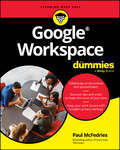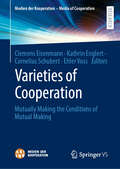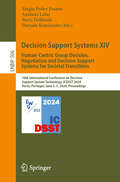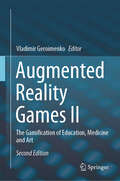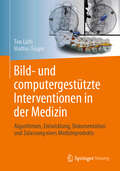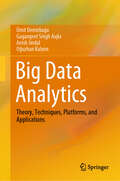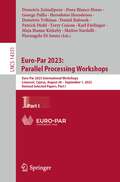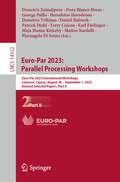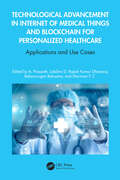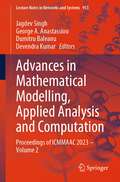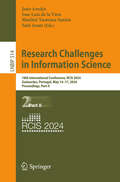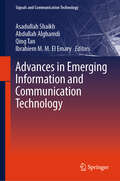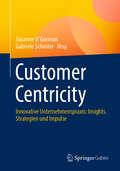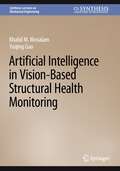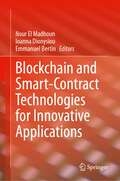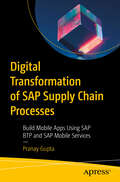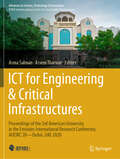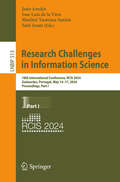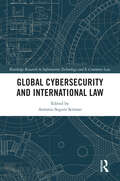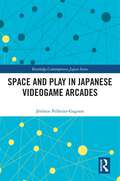- Table View
- List View
Google Workspace For Dummies
by Paul McFedriesEasy advice for getting the most out of Google Workspace for school, work, or personal use Google Workspace For Dummies is here to show you the tips and tricks for upping your productivity with Google's cloud-based software suite. This book includes jargon-free instructions on using Gmail, Calendar, Docs, Sheets, Drive, Chat, and Meet. You'll learn about the AI features, updated security, compatibility with other apps, picture-in-picture capability for video meetings, and beyond. Plus, you'll get info on Google's Forms and Notes feature that makes it simple to gather and share data and stay up-to-date with your team. It's easier than ever to collaborate securely in the cloud, thanks to this Dummies book. Learn how to collaborate with colleagues in real time using the programs that come with Google Workspace Create and edit contacts, and set up video meetings Work on slides, spreadsheets, and documents Discover tips and tricks to increase productivity and keep your work secure Google Workspace For Dummies is a must for business users and workers who use Google applications on the job. Casual users and students, you'll love it, too.
Varieties of Cooperation: Mutually Making the Conditions of Mutual Making (Medien der Kooperation – Media of Cooperation)
by Clemens Eisenmann Kathrin Englert Cornelius Schubert Ehler VossThis volume conceives cooperation in broad terms as any form of mutual making, in which goals, means, and procedures are seen as ongoing accomplishments. From the exchanges of goods or information, to the interactions between bodies or organizations, and the coordination between colleagues, competitors, friends or foes. Mutually making the conditions of mutual making entails translating heterogeneous interests, negotiating conflicting values and articulating distributed activities. On the one hand, the contributions cover different notions and concepts of cooperation in diverse fields of study: from the mundane cooperation of everyday life to collective endeavors within specific domains. On the other hand, the contributions share a focus on the practices of making cooperation possible through cooperatively creating the conditions for cooperation itself. Seeing cooperative media both as a condition and consequence of cooperation, the volume sheds light on a general feature of media, technologies and instruments that both enable and constrain the collaboration between heterogeneous social worlds, with and without consensus. Chapter 7 “The Passport as a Medium of Movement” is available open access under a Creative Commons Attribution 4.0 International License via SpringerLink.
Decision Support Systems XIV. Human-Centric Group Decision, Negotiation and Decision Support Systems for Societal Transitions: 10th International Conference on Decision Support System Technology, ICDSST 2024, Porto, Portugal, June 3–5, 2024, Proceedings (Lecture Notes in Business Information Processing #506)
by Sérgio Pedro Duarte António Lobo Boris Delibašić Daouda KamissokoThis book constitutes the proceedings of the 10th International Conference on Decision Support Systems Technologies, ICDSST 2024, held in June 2024. The EWG-DSS series of International Conference on Decision Support System Technology (ICDSST) is planned to consolidate the tradition of annual events organized by the EWG-DSS in offering a platform for European and international DSS communities, comprising the academic and industrial sectors, to present state-of-the-art DSS research and developments, to discuss current challenges that surround decision-making processes, to exchange ideas about realistic and innovative solutions, and to co-develop potential business opportunities. This year the main topic was: Human-Centric Group Decision, Negotiation and Decision Support Systems for Societal Transitions. The 10 full papers included in these proceedings were carefully reviewed and selected from 29 submissions. They have been organized in topical sections as follows: Decision support tools and methods; and decision factors.
Augmented Reality Games II: The Gamification of Education, Medicine and Art
by Vladimir GeroimenkoThis is the second edition of the first ever research monograph that explores the exciting field of augmented reality games and their enabling technologies. The new edition has been thoroughly revised and updated, with 6 new chapters included. As well as investigating augmented reality games in education, the book covers the gamification of medicine, healthcare, and art. It has been written by a team of 43 researchers, practitioners, and artists from 12 countries, pioneering in developing and researching the new type of computer games.This book deals with a systematic analysis of educational augmented reality games, the gamification of elementary and secondary education, teachers’ novel key skills and new teaching methods in the classroom, creating immersive and playful reading experiences, augmented reality games for health promotion in old age and for transforming dental and physical education and practice, the gamification of augmented reality art, pervasive games, and gaming in public spaces, among other topics.Intended as a starting point for exploring this new fascinating area of research and game development, it will be essential reading not only for researchers, practitioners, game developers, and artists, but also for students (graduates and undergraduates) and all those interested in the rapidly developing area of augmented reality games.
Bild- und computergestützte Interventionen in der Medizin: Algorithmen, Entwicklung, Dokumentation und Zulassung eines Medizinprodukts
by Tim Christian Lüth Mattias Felix TrägerDieses Buch richtet sich an Ingenieure, Informatiker sowie interessierte Angehörige der medizinischen und pflegerischen Berufe. Es erklärt die Grundlagen und Anwendungen der computerassistierten- und robotergestützten Medizingeräte auf dem aktuellen Stand der Technik. Derartige Systeme haben in den letzten 20 Jahren revolutionäre positive Veränderungen in der Radiologie, bei Interventionen und in vielen Gebieten der Chirurgie bewirkt. Mit dieser Technik ist es möglich, Bilddaten aus unterschiedlichen bildgebenden Systemen – wie z.B. Computertomograph, Ultraschall-gerät oder Videoendoskop – zu fusionieren, am Bildschirm dreidimensional darzustellen und darin mit dem Computer Eingriffe zu planen. Während der Operation wird die räumliche Lage des navigierten Instruments gemessen und im 3D-Modell des Patienten am Bildschirm dargestellt. Geplante Pfade der Instrumente werden eingeblendet, es wird vor Risiken bei Abweichungen von der Planung gewarnt und es können aktive Instrumente wie Bohrer, Fräser, Laser oder sogar Roboter automatisiert gesteuert werden. Die Autoren sind auf diesem Gebiet seit über 25 Jahren sowohl wissenschaftlich als auch unternehmerisch international führend tätig, weshalb in diesem Buch auch Entwicklungsmethodik, Dokumentation, Zulassung und Inverkehrbringung als Medizinprodukt praxisnah erläutert werden.
Big Data Analytics: Theory, Techniques, Platforms, and Applications
by Ümit Demirbaga Gagangeet Singh Aujla Anish Jindal Oğuzhan KalyonThis book introduces readers to big data analytics. It covers the background to and the concepts of big data, big data analytics, and cloud computing, along with the process of setting up, configuring, and getting familiar with the big data analytics working environments in the first two chapters. The third chapter provides comprehensive information on big data processing systems - from installing these systems to implementing real-world data applications, along with the necessary codes. The next chapter dives into the details of big data storage technologies, including their types, essentiality, durability, and availability, and reveals their differences in their properties. The fifth and sixth chapters guide the reader through understanding, configuring, and performing the monitoring and debugging of big data systems and present the available commercial and open-source tools for this purpose. Chapter seven gives information about a trending machine learning, Bayesian network: a probabilistic graphical model, by presenting a real-world probabilistic application to understand causal, complex, and hidden relationships for diagnosis and forecasting in a scalable manner for big data. Special sections throughout the eighth chapter present different case studies and applications to help the readers to develop their big data analytics skills using various big data analytics frameworks.The book will be of interest to business executives and IT managers as well as university students and their course leaders, in fact all those who want to get involved in the big data world.
Euro-Par 2023: Euro-Par 2023 International Workshops, Limassol, Cyprus, August 28 – September 1, 2023, Revised Selected Papers, Part I (Lecture Notes in Computer Science #14351)
by Demetris Zeinalipour Dora Blanco Heras George Pallis Herodotos Herodotou Demetris Trihinas Daniel Balouek Patrick Diehl Terry Cojean Karl Fürlinger Maja Hanne Kirkeby Matteo Nardelli Pierangelo Di SanzoThis book constitutes revised selected papers from the workshops held at the 29th International Conference on Parallel and Distributed Computing, Euro-Par 2023, which took place in Limassol, Cyprus, during August 28–September 1, 2023. The 42 full papers presented in this book together with 11 symposium papers and 14 demo/poster papers were carefully reviewed and selected from 55 submissions. The papers cover covering all aspects of parallel and distributed processing, ranging from theory to practice, from small to the largest parallel and distributed systems and infrastructures, from fundamental computational problems to applications, from architecture, compiler, language and interface design and implementation, to tools, support infrastructures, and application performance aspects.LNCS 14351:First International Workshop on Scalable Compute Continuum (WSCC 2023). First International Workshop on Tools for Data Locality, Power and Performance (TDLPP 2023). First International Workshop on Urgent Analytics for Distributed Computing (QuickPar 2023). 21st International Workshop on Algorithms, Models and Tools for Parallel Computing on Heterogeneous Platforms (HETEROPAR 2023). LNCS 14352: Second International Workshop on Resource AWareness of Systems and Society (RAW 2023). Third International Workshop on Asynchronous Many-Task systems for Exascale (AMTE 2023). Third International Workshop on Performance and Energy-efficiency in Concurrent and Distributed Systems (PECS 2023) First Minisymposium on Applications and Benefits of UPMEM commercial Massively Parallel Processing-In-Memory Platform (ABUMPIMP 2023). First Minsymposium on Adaptive High Performance Input / Output Systems (ADAPIO 2023).
Euro-Par 2023: Euro-Par 2023 International Workshops, Limassol, Cyprus, August 28 – September 1, 2023, Revised Selected Papers, Part II (Lecture Notes in Computer Science #14352)
by Demetris Zeinalipour Dora Blanco Heras George Pallis Herodotos Herodotou Demetris Trihinas Daniel Balouek Patrick Diehl Terry Cojean Karl Fürlinger Maja Hanne Kirkeby Matteo Nardelli Pierangelo Di SanzoThis book constitutes revised selected papers from the workshops held at the 29th International Conference on Parallel and Distributed Computing, Euro-Par 2023, which took place in Limassol, Cyprus, during August 28–September 1, 2023. The 42 full papers presented in this book together with 11 symposium papers and 14 demo/poster papers were carefully reviewed and selected from 55 submissions. The papers cover covering all aspects of parallel and distributed processing, ranging from theory to practice, from small to the largest parallel and distributed systems and infrastructures, from fundamental computational problems to applications, from architecture, compiler, language and interface design and implementation, to tools, support infrastructures, and application performance aspects. LNCS 14351: First International Workshop on Scalable Compute Continuum (WSCC 2023). First International Workshop on Tools for Data Locality, Power and Performance (TDLPP 2023). First International Workshop on Urgent Analytics for Distributed Computing (QuickPar 2023). 21st International Workshop on Algorithms, Models and Tools for Parallel Computing on Heterogeneous Platforms (HETEROPAR 2023). LNCS 14352: Second International Workshop on Resource AWareness of Systems and Society (RAW 2023). Third International Workshop on Asynchronous Many-Task systems for Exascale (AMTE 2023). Third International Workshop on Performance and Energy-efficiency in Concurrent and Distributed Systems (PECS 2023) First Minisymposium on Applications and Benefits of UPMEM commercial Massively Parallel Processing-In-Memory Platform (ABUMPIMP 2023). First Minsymposium on Adaptive High Performance Input / Output Systems (ADAPIO 2023).
Technological Advancement in Internet of Medical Things and Blockchain for Personalized Healthcare: Applications and Use Cases
Technological Advancement in Internet of Medical Things and Blockchain for Personalized Healthcare presents an overview of the innovative concepts, technologies, and various biomedical applications of the Internet of Medical Things (IoMT).Features:• Provides insights into smart contracts, healthcare monitoring equipment, and the next generation of Internet of Things sensors to improve adherence to chronic disease management programs and patient health.• Discusses the IoMT for personalized healthcare, security, and privacy issues of the IoMT in the healthcare sector.• Elaborates on the opportunities and challenges of blockchain technology in the healthcare system.• Focuses on the convergence of the IoMT and blockchain for emerging personalized healthcare systems.• Presents techniques and methods to secure IoMT devices to protect them from cyberattacks.This book is primarily written for graduate students and academic researchers working in the fields of computer science and engineering, biomedical engineering, and electrical engineering.
Technological Advancement in Internet of Medical Things and Blockchain for Personalized Healthcare: Applications and Use Cases
by A. Prasanth D Lakshmi Rajesh Kumar Dhanaraj Balamurugan BalusamyTechnological Advancement in Internet of Medical Things and Blockchain for Personalized Healthcare presents an overview of the innovative concepts, technologies, and various biomedical applications of the Internet of Medical Things (IoMT).Features:• Provides insights into smart contracts, healthcare monitoring equipment, and the next generation of Internet of Things sensors to improve adherence to chronic disease management programs and patient health.• Discusses the IoMT for personalized healthcare, security, and privacy issues of the IoMT in the healthcare sector.• Elaborates on the opportunities and challenges of blockchain technology in the healthcare system.• Focuses on the convergence of the IoMT and blockchain for emerging personalized healthcare systems.• Presents techniques and methods to secure IoMT devices to protect them from cyberattacks.This book is primarily written for graduate students and academic researchers working in the fields of computer science and engineering, biomedical engineering, and electrical engineering.
Advances in Mathematical Modelling, Applied Analysis and Computation: Proceedings of ICMMAAC 2023 – Volume 2 (Lecture Notes in Networks and Systems #953)
by Jagdev Singh George A. Anastassiou Dumitru Baleanu Devendra KumarThis book gathers selected research articles presented in the “6th International Conference on Mathematical Modelling, Applied Analysis and Computation (ICMMAAC)”, held at JECRC University, Jaipur, during August 3–5, 2023. This book is focused on articles dealing with necessary theory and techniques in a balanced manner, and contributes towards solving mathematical problems arising in physics, engineering, chemistry, biological systems, medicine, networking system, control systems, environmental sciences, social issues of current interest and more. Annually held since 2018, the ICMMAAC conference aimed, in particular, to foster cooperation among practitioners and theoreticians in these fields. This proceedings is an invaluable resource for researchers, academicians and professionals associated or interested in current advances in different aspects of mathematical modelling, computational algorithms and analysis necessary for handling real-world problems.
Enterprise GENERATIVE AI Well-Architected Framework & Patterns: An Architect's Real-life Guide to Adopting Generative AI in Enterprises at Scale
by Suvoraj BiswasElevate your AI projects with our course on Enterprise Generative AI using AWS's Well-Architected Framework, paving the way for innovation and efficiencyKey FeaturesLearn to secure AI environmentsAchieve excellence in AI architectureImplement AI with AWS solutionsBook DescriptionThe course begins with an insightful introduction to the burgeoning field of Generative AI, laying down a robust framework for understanding its applications within the AWS ecosystem. The course focuses on meticulously detailing the five pillars of the AWS Well-Architected Framework—Operational Excellence, Security, Compliance, Reliability, and Cost Optimization. Each module is crafted to provide you with a comprehensive understanding of these essential areas, integrating Generative AI technologies. You'll learn how to navigate the complexities of securing AI systems, ensuring they comply with legal and regulatory standards, and designing them for unparalleled reliability. Practical sessions on cost optimization strategies for AI projects will empower you to deliver value without compromising on performance or scalability. Furthermore, the course delves into System Architecture Excellence, emphasizing the importance of robust design principles in creating effective Generative AI solutions. The course wraps up by offering a forward-looking perspective on the Common Architectural Pattern for FM/LLM Integration & Adoption within the AWS framework. You'll gain hands-on experience with AWS solutions specifically tailored for Generative AI applications, including Lambda, API Gateway, and DynamoDB, among others.What you will learnApply Operational Excellence in AISecure Generative AI implementationsNavigate compliance in AI solutionsEnsure reliability in AI systemsOptimize costs for AI projectsIntegrate FM/LLM with AWS solutionsWho this book is forThis course is designed for IT professionals, solutions architects, and DevOps engineers looking to specialize in Generative AI. A foundational understanding of AWS and cloud computing is beneficial.
Qt 6 C++ GUI Programming Cookbook: Practical recipes for building cross-platform GUI applications, widgets, and animations with Qt 6
by Lee Zhi EngUse Qt 6 to design and build functional, appealing, and user-friendly graphical user interfaces (GUIs) for your applicationsKey FeaturesLearn to use Qt 6 to design and customize the look and feel of your applicationsImprove the visual quality of an application by using graphics rendering and animationUnderstand the balance of presentation and web content that will make an application appealing yet functionalPurchase of the print or Kindle book includes a free PDF eBookBook DescriptionWith the growing need to develop GUIs for multiple targets and multiple screens, improving the visual quality of your application has become pivotal in helping it stand out from your competitors. With its cross-platform ability and the latest UI paradigms, Qt makes it possible to build intuitive, interactive, and user-friendly UIs for your applications. The third edition of Qt 6 C++ GUI Programming Cookbook teaches you how to develop functional and appealing UIs using the latest version of Qt 6 and C++. This book will help you learn a variety of topics such as GUI customization and animation, graphics rendering, and implementing Google Maps. You’ll also be taken through advanced concepts such as asynchronous programming, event handling using signals and slots, network programming, and other aspects to optimize your application. By the end of this Qt book, you’ll have the confidence you need to design and customize GUI applications that meet your clients' expectations and have an understanding of best-practice solutions to common problems during the app development process.What you will learnAnimate GUI elements using Qt 6's built-in animation systemDraw vector shapes and bitmap images using Qt 6's powerful rendering systemImplement an industry-standard OpenGL library in your projectBuild a mobile app that supports touch events and export it into devicesParse and extract data from an XML file and present it on your GUIInteract with web content by calling JavaScript functions from C++Access MySQL and SQLite databases to retrieve data and display it on your GUIWho this book is forThis intermediate-level book is designed for those who want to develop software using Qt 6. If you want to improve the visual quality and content presentation of your software application, this book is for you. Prior experience with the C++ programming language is required.
Mastering Kotlin for Android 14: Build powerful Android apps from scratch using Jetpack libraries and Jetpack Compose
by Harun WangerekaAccelerate your Android development journey by mastering the latest Kotlin techniques and libraries to build robust appsKey FeaturesApply best practices and industry-essential skills used by Google Developer ExpertsFind out how to publish, monitor, and improve your app metrics on the Google Play StoreLearn how to debug issues, detect leaks, inspect network calls, and inspect your app’s local databasePurchase of the print or Kindle book includes a free PDF eBookBook DescriptionWritten with the best practices, this book will help you master Kotlin and use its powerful language features, libraries, tools, and APIs to elevate your Android apps. As you progress, you'll use Jetpack Compose and Material Design 3 to build UIs for your app, explore how to architect and improve your app architecture, and use Jetpack Libraries like Room and DataStore to persist your data locally. Using a step-by-step approach, this book will teach you how to debug issues in your app, detect leaks, inspect network calls fired by your app, and inspect your Room database. You'll also add tests to your apps to detect and address code smells. Toward the end, you’ll learn how to publish apps to the Google Play Store and see how to automate the process of deploying consecutive releases using GitHub actions, as well as learn how to distribute test builds to Firebase App Distribution. Additionally, the book covers tips on how to increase user engagement. By the end of this Kotlin book, you’ll be able to develop market-ready apps, add tests to their codebase, address issues, and get them in front of the right audience.What you will learnBuild beautiful, responsive, and accessible UIs with Jetpack ComposeExplore various app architectures and find out how you can improve themPerform code analysis and add unit and instrumentation tests to your appsPublish, monitor, and improve your apps in the Google Play StorePerform long-running operations with WorkManager and persist data in your appUse CI/CD with GitHub Actions and distribute test builds with Firebase App DistributionFind out how to add linting and static checks on CI/CD pipelinesWho this book is forIf you’re an aspiring Android developer or an Android developer working with Java, then this book is for you. Basic Java programming skills are a must if you want to fully utilize the techniques and best practices showcased in this book.
Research Challenges in Information Science: 18th International Conference, RCIS 2024, Guimarães, Portugal, May 14–17, 2024, Proceedings, Part II (Lecture Notes in Business Information Processing #514)
by João Araújo Jose Luis de la Vara Maribel Yasmina Santos Saïd AssarThis book constitutes the proceedings of the 18th International Conference on Research Challenges in Information Sciences, RCIS 2024, which took place in Guimarães, Portugal, during May 2024. The scope of RCIS is summarized by the thematic areas of information systems and their engineering; user-oriented approaches; data and information management; business process management; domain-specific information systems engineering; data science; information infrastructures, and reflective research and practice. The 25 full papers, 12 Forum and 5 Doctoral Consortium papers included in these proceedings were carefully reviewed and selected from 100 submissions. They were organized in topical sections as follows: Part I: Data and information management; conceptual modelling and ontologies; requirements and architecture; business process management; data and process science; security; sustainability; evaluation and experience studies Part II: Forum papers; doctoral consortium papers.
Advances in Emerging Information and Communication Technology (Signals and Communication Technology)
by Asadullah Shaikh Abdullah Alghamdi Qing Tan Ibrahiem M. M. El EmaryThe book presents the proceedings of the International Conference on Innovation of Emerging Communication and Information Technology (ICIEICT 2023), which took place September 11 to 13, 2023, virtually and in Madrid, Spain. The conference is devoted to communication, computer science, electrical and electronics engineering, telecommunication engineering, and information technology. The conference is intended to provide a forum for research scientists, engineers, educators, and practitioners throughout the world to learn, share knowledge, publish, and disseminate the most recent innovations and developments, ideas, and applications in all fields of science, technology and information technology.
Customer Centricity: Innovative Unternehmenspraxis: Insights, Strategien und Impulse
by Susanne O’Gorman Gabriele SchusterDieses Buch schlägt eine Brücke zwischen wissenschaftlicher Forschung zu Customer Centricity und ihrer praxisorientierten Anwendung. Das Interesse und die Begeisterung für Customer Centricity sind seit einigen Jahren ungebrochen, doch trotz reger Forschungstätigkeit und großem Interesse aus der Praxis scheitern viele Unternehmen nach wie vor an der Umsetzung. Zahlreiche Beitragsautor:innen betrachten in diesem Buch sowohl die Perspektive der Konsument:innen als auch der Unternehmen und integrieren zukunftsorientierte Ansätze wie Design Thinking, Augmented/Virtual Reality und CX-Plattformen. Die Leser:innen erhalten wissenschaftlich fundierte Handlungsempfehlungen für ein kundenzentriertes Unternehmen von praxiserfahrenen Expert:innen.Mit Beiträgen von:Prof. Dr. Laura-Maria AltendorferElaine BecraftProf. Dr. Thomas BolzProf. Dr. Benny BriesemeisterChristian FeddersenCharlotte FietzLivia FreudlTim GnanntProf. Dr. Stefan Godehardt-BestmannDr. Gregor ElbelProf. Dr. Katja GruppMatthias HackenbrachtProf. Dr. Cansu HattulaProf. Dr. Clare HindleyProf. Dr. Nicole KleinProf. Dr. Alexandra KühtePhilip MaloneyProf. Dr. Rico ManßProf. Dr. Astrid MühlböckProf. Dr. Bettina-Maria Müller Prof. Dr. Miriam O’SheaProf. Dr. Katharina RehfeldProf. Dr. Christian SchachtnerProf. Dr. Katrin E. ScheinProf. Dr. Uta ScheunertProf. Dr. Inga F. SchlömerProf. Dr. Benjamin Schulte Stephan SchusserMelanie StehrDr. Sascha TammTimo ThuencherNeal WesslingProf. Dr. Annegret Wittmann-Wurzer Prof. Dr. Nicola ZechProf. Dr. Matthias ZeisbergDr. Li Zeng
Artificial Intelligence in Vision-Based Structural Health Monitoring (Synthesis Lectures on Mechanical Engineering)
by Khalid M. Mosalam Yuqing GaoThis book provides a comprehensive coverage of the state-of-the-art artificial intelligence (AI) technologies in vision-based structural health monitoring (SHM). In this data explosion epoch, AI-aided SHM and rapid damage assessment after natural hazards have become of great interest in civil and structural engineering, where using machine and deep learning in vision-based SHM brings new research direction. As researchers begin to apply these concepts to the structural engineering domain, especially in SHM, several critical scientific questions need to be addressed: (1) What can AI solve for the SHM problems? (2) What are the relevant AI technologies? (3) What is the effectiveness of the AI approaches in vision-based SHM? (4) How to improve the adaptability of the AI approaches for practical projects? (5) How to build a resilient AI-aided disaster prevention system making use of the vision-based SHM? This book introduces and implements the state-of-the-art machine learning and deep learning technologies for vision-based SHM applications. Specifically, corresponding to the above-mentioned scientific questions, it consists of: (1) motivation, background & progress of AI-aided vision-based SHM, (2) fundamentals of machine learning & deep learning approaches, (3) basic AI applications in vision-based SHM, (4) advanced topics & approaches, and (5) resilient AI-aided applications. In the introduction, a brief coverage about the development progress of AI technologies in the vision-based area is presented. It gives the readers the motivations and background of the relevant research. In Part I, basic knowledges of machine and deep learning are introduced, which provide the foundation for the readers irrespective of their background. In Part II, to verify the effectiveness of the AI methods, the key procedure of the typical AI-aided SHM applications (classification, localization, and segmentation) is explored, including vision data collection, data pre-processing,transfer learning-based training mechanism, evaluation, and analysis. In Part III, advanced AI topics, e.g., generative adversarial network, semi-supervised learning, and active learning, are discussed. They aim to address several critical issues in practical projects, e.g., the lack of well-labeled data and imbalanced labels, to improve the adaptability of the AI models. In Part IV, the new concept of “resilient AI” is introduced to establish an intelligent disaster prevention system, multi-modality learning, multi-task learning, and interpretable AI technologies. These advances are aimed towards increasing the robustness and explainability of the AI-enabled SHM system, and ultimately leading to improved resiliency.The scope covered in this book is not only beneficial for education purposes but also is essential for modern industrial applications. The target audience is broad and includes students, engineers, and researchers in civil engineering, statistics, and computer science. Unique Book Features:• Provide a comprehensive review of the rapidly expanding field of vision-based structural health monitoring (SHM) using artificial intelligence approaches. • Re-organize fundamental knowledge specific to the machine and deep learning in vision tasks.• Include comprehensive details about the procedure of conducting AI approaches for vision-based SHM along with examples and exercises.• Cover a vast array of special topics and advanced AI-enabled vision-based SHM applications.• List a few potential extensions for inspiring the readers for future investigation.
Blockchain and Smart-Contract Technologies for Innovative Applications
by Nour El Madhoun Ioanna Dionysiou Emmanuel BertinThis book is an in-depth exploration of blockchain and smart contracts technologies, systematically addressing their theoretical foundations while highlighting concrete applications in several key sectors. It begins by defining the fundamentals of blockchain and smart contracts, then ventures into the legal domain, analyzing the implications of automated contracts from both backend and frontend perspectives. A particular focus is placed on a sustainable design for cryptocurrencies, anticipating the principles and expectations of the future. The book then provides a detailed taxonomy of blockchain's financial applications, while also examining its role in managing scientific workflows. The fascinating world of NFTs is also explored, from the tokenization of fine arts to innovative event ticketing systems. The convergence between ontologies and blockchain technology is then highlighted, followed by an in-depth assessment of the implications of this technology in the telecommunicationssector, including a SWOT analysis of next-generation cellular networks. Written by academic researchers and industry experts, this book offers a complete and nuanced perspective on the transformational potential of blockchain.
Digital Transformation of SAP Supply Chain Processes: Build Mobile Apps Using SAP BTP and SAP Mobile Services
by Pranay GuptaTake a high-level tour of SAP oDATA integrations with frontend technologies like Angular using the SAP Mobile Services Platform. This book will give you a different perspective on executing SAP transactions on iOS using Angular instead of SAP-provided Fiori-based applications. You’ll start by learning about SAP supply chain processes such as Goods Receipt, Transfer Posting, Goods Issue, and Inventory Search. You’ll then move on to understanding the thought process involved in integrating SAP's backend (SAP ECC) with Angular iOS app using SAP Mobile Services running on SAP BTP. All this will serve as a guide tailored to SAP functional and technical consultants actively engaged in client-facing roles. You’ll follow a roadmap for modernizing and streamlining supply chain operations by leveraging Angular iOS apps. Digital Transformation of SAP Supply Chain Processes provides the essential tools for businesses looking to stay competitive in today's technology-driven landscape. What You Will Learn Study the fundamental procedures to set up the Authorization Endpoint, Token Endpoint, and base URL within SAP Mobile Services.Manage attachments in mobile applications and store them in an external content repository. Gain proficiency in testing OData services using the POSTMAN API client with OAuth protocol.Acquire knowledge about the JSON messages, CORS protocol, and X-CSRF token exchange.Link Zebra Printers through the Zebra Native Printing app on iOS App to print SAP forms on mobile printers. Who This Book Is For SAP Consultants with an interest in the Digital Transformation of SAP Supply Chain Processes to iOS-based SAP transactions.
ICT for Engineering & Critical Infrastructures: Proceedings of the 3rd American University in the Emirates International Research Conference, AUEIRC'20—Dubai, UAE 2020 (Advances in Science, Technology & Innovation)
by Asma Salman Assem TharwatThis book—consisting of four parts—brings forth a comprehensive evaluation of information and communication technologies (ICTs) utilization in engineering and infrastructures. The field of engineering has consistently been a bastion of problem-solving and innovation. It has continuously aided humanity in conquering seemingly unsolvable obstacles by pushing the limits of human capability and ingenuity. In the modern age, modern computational methods and digital systems present themselves as the frontier of novel technological innovation, thus attaining the potential to considerably strengthen various engineering fields. Tackling essential topics such as the incorporation of informatics in infrastructure, cybersecurity, advanced networking techniques, and smart resource management, this book peers into the future of engineering, proving as an excellent resource for engineers, entrepreneurs, policymakers, network specialists, and finally, computer scientists.
Research Challenges in Information Science: 18th International Conference, RCIS 2024, Guimarães, Portugal, May 14–17, 2024, Proceedings, Part I (Lecture Notes in Business Information Processing #513)
by João Araújo Jose Luis de la Vara Maribel Yasmina Santos Saïd AssarThis book constitutes the proceedings of the 18th International Conference on Research Challenges in Information Sciences, RCIS 2024, which took place in Guimarães, Portugal, during May 2024. The scope of RCIS is summarized by the thematic areas of information systems and their engineering; user-oriented approaches; data and information management; business process management; domain-specific information systems engineering; data science; information infrastructures, and reflective research and practice. The 25 full papers, 12 Forum and 5 Doctoral Consortium papers included in these proceedings were carefully reviewed and selected from 100 submissions. They were organized in topical sections as follows: Part I: Data and information management; conceptual modelling and ontologies; requirements and architecture; business process management; data and process science; security; sustainability; evaluation and experience studies Part II: Forum papers; doctoral consortium papers.
Global Cybersecurity and International Law (Routledge Research in Information Technology and E-Commerce Law)
This book offers a critical analysis of cybersecurity from a legal-international point of view.Assessing the need to regulate cyberspace has triggered the re-emergence of new primary norms. This book evaluates the ability of existing international law to address the threat and use of force in cyberspace, redefining cyberwar and cyberpeace for the era of the Internet of Things. Covering critical issues such as the growing scourge of economic cyberespionage, international co-operation to fight cybercrime, the use of foreign policy instruments in cyber diplomacy, it also looks at state backed malicious cyberoperations, and the protection of human rights against State security activities. Offering a holistic examination of the ability of public international law, the book addresses the most pressing issues in global cybersecurity.Reflecting on the reforms necessary from international institutions, like the United Nations, the European Union, the Council of Europe, and NATO, in order to provide new answers to the critical issues in global cybersecurity and international law, this book will be of interest to academics, students and practitioners.
Global Cybersecurity and International Law (Routledge Research in Information Technology and E-Commerce Law)
by Antonio Segura SerranoThis book offers a critical analysis of cybersecurity from a legal-international point of view.Assessing the need to regulate cyberspace has triggered the re-emergence of new primary norms. This book evaluates the ability of existing international law to address the threat and use of force in cyberspace, redefining cyberwar and cyberpeace for the era of the Internet of Things. Covering critical issues such as the growing scourge of economic cyberespionage, international co-operation to fight cybercrime, the use of foreign policy instruments in cyber diplomacy, it also looks at state backed malicious cyberoperations, and the protection of human rights against State security activities. Offering a holistic examination of the ability of public international law, the book addresses the most pressing issues in global cybersecurity.Reflecting on the reforms necessary from international institutions, like the United Nations, the European Union, the Council of Europe, and NATO, in order to provide new answers to the critical issues in global cybersecurity and international law, this book will be of interest to academics, students and practitioners.
Space and Play in Japanese Videogame Arcades (Routledge Contemporary Japan Series)
by Jérémie Pelletier-GagnonThis book presents a scholarly investigation of the development and culture of Japanese videogame arcades, both from a historical and contemporary point of view.Providing an overview of the historical evolution of public amusement spaces from the early rooftop amusement spaces from the early nineteenth century to the modern multi‑floor and interconnected arcade complexes that characterize the urban fabric of contemporary Japan, the book argues that arcade videogames and their associated practices must be examined in the context in which they are played, situated in the interrelation between the game software, the cabinets as material conditions of play, and the space of the venue that frames the experience. Including three case studies of distinct and significant game centres located in Tokyo and Kyoto, the book addresses of play in public, including the notion of performance and observation as play practices, spatial appropriation, as well as the compartmentalization of the play experience.In treating videogames as sets of circumstances, the book identifies the opportunities for ludic practices that videogame arcades provide in Japan. As such, it will appeal to students and scholars of Game Studies and Digital Media Studies, as well as those of Japanese Culture and Society.
